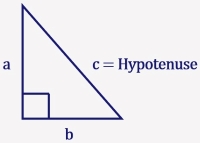
- The longest side of a right triangle is called the Hypotenuse
- Corresponding to the largest angle of the triangle, the Hypotenuse is opposite the right angle
- Applying the Pythagorean Theorem, the Hypotenuse c is equal to the square root of the sum of the leg lengths squared, or

Hypotenuse (Wikipedia)
This article has multiple issues. Please help improve it or discuss these issues on the talk page. (Learn how and when to remove these template messages)
(Learn how and when to remove this template message)
|
In geometry, a hypotenuse is the longest side of a right-angled triangle, the side opposite the right angle. The length of the hypotenuse of a right triangle can be found using the Pythagorean theorem, which states that the square of the length of the hypotenuse equals the sum of the squares of the lengths of the other two sides. For example, if one of the other sides has a length of 3 (when squared, 9) and the other has a length of 4 (when squared, 16), then their squares add up to 25. The length of the hypotenuse is the square root of 25, that is, 5.

